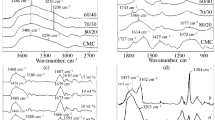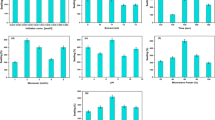Abstract
Herein, a series of pH-responsive composite hydrogels based on carrageenan (CG) and synthetic polymer poly (N-vinyl-2-pyrrolidone) (PVP) was developed by using 3-aminopropyl triethoxysilane (APTES) as cross-linker. The formation of the hydrogel was confirmed with the help of Fourier-transform infrared spectroscopy (FTIR). The FTIR spectra revealed the presence of all functionalities at their specific wavenumbers. The thermal stability of the as prepared composite hydrogels and pristine carrageenan and PVP was evaluated with the help of thermogravimetric analysis (TGA). The obtained thermo-grams portrays that the composite hydrogels are thermally more stable as compared to the pristine hydrogels. Furthermore, antibacterial investigations exhibit good activities against S. aureus a gram-positive strain indicating that the as prepared hydrogels can be employed for the biological applications. Additionally, the time-dependent sustainability of the composite hydrogels was confirmed by biodegradation analysis. The results obtained are in well agreement with the reported results. Also, the swelling behavior of the hydrogels was examined against different media using different concentrations of the APTES. The percentage of swelling in water for hydrogel samples was increased with the quantity of APTES. The different pH of the same solutions explains the swelling behavior in dependable way as hydrogels exhibit inverse relation of swelling with pH; in acidic medium, i.e., at low pH, maximum swelling was observed and vice versa. This idiosyncratic behavior of these synthesized hydrogels and its sustainability favors their use for control release of fertilizers. The release pattern was studied by spectrophotometer using indophenol blue at 640 nm showed 86.82% of fertilizer release over a period of 216 h in a phosphate buffer saline (PBS) in a controlled manner.
Graphical Abstract










Similar content being viewed by others
References
Ganguly S, Das NC (2017) Water uptake kinetics and control release of agrochemical fertilizers from nanoclay-assisted semi-interpenetrating sodium acrylate-based hydrogel. Polym-Plast Technol Eng 56(7):744–761
Cheng D et al (2018) Water-and fertilizer-integrated hydrogel derived from the polymerization of acrylic acid and urea as a slow-release N fertilizer and water retention in agriculture. J Agric Food Chem 66(23):5762–5769
Li X et al (2016) Characterization, swelling and slow-release properties of a new controlled release fertilizer based on wheat straw cellulose hydrogel. J Taiwan Inst Chem Eng 60:564–572
Cunha PL et al (2005) Low viscosity hydrogel of guar gum: preparation and physicochemical characterization. Int J Biol Macromol 37(1–2):99–104
Zhang M et al (2016) Photodegradation of phenol via C3N4-agar hybrid hydrogel 3D photocatalysts with free separation. Appl Catal B 183:263–268
Rasool A et al (2020) Kinetics and controlled release of lidocaine from novel carrageenan and alginate-based blend hydrogels. Int J Biol Macromol 147:67–78
Lee KY, Bouhadir KH, Mooney DJ (2004) Controlled degradation of hydrogels using multi-functional cross-linking molecules. Biomaterials 25(13):2461–2466
Ramazani A, Aghahosseini H (2020) The biological properties of hydrogels based on natural polymers. Hydrogels Based on Natural Polymers. Elsevier, pp 247–269
Gong JP (2006) Friction and lubrication of hydrogels—its richness and complexity. Soft Matter 2(7):544–552
Kim DW et al (2015) Novel sodium fusidate-loaded film-forming hydrogel with easy application and excellent wound healing. Int J Pharm 495(1):67–74
Liu H et al (2010) Magnetic hydrogels with supracolloidal structures prepared by suspension polymerization stabilized by Fe2O3 nanoparticles. Acta Biomater 6(1):275–281
Qureshi MA et al (2022) Chitosan and carrageenan-based biocompatible hhydrogel platforms for cosmeceutical, drug delivery, and biomedical applications. Starch-Stärke p 2200052
Distantina S, Fahrurrozi M (2011) Carrageenan properties extracted from Eucheuma cottonii, Indonesia. International Journal of Chemical and Molecular Engineering 5(6):487–491
Wang Q et al (2005) Gelation behaviour of aqueous solutions of different types of carrageenan investigated by low-intensity-ultrasound measurements and comparison to rheological measurements. Innov Food Sci Emerg Technol 6(4):465–472
Abad LV et al (2003) Properties of radiation synthesized PVP-kappa carrageenan hydrogel blends. Radiat Phys Chem 68(5):901–908
Hassankhani R, Hassankhani R (2012) Intellectual properties in agriculture. Intern Res J App Basic Sci
Alcântara MT, Lugao AB, Taqueda ME (2009) Experimental design of mixture applied to study PVP hydrogels properties crosslinked by ionizing radiation.
Fuentes M et al (2018) New methodology to assess the quantity and quality of humic substances in organic materials and commercial products for agriculture. J Soils Sediments 18(4):1389–1399
Qin J-J et al (2003) Cellulose acetate hollow fiber ultrafiltration membranes made from CA/PVP 360 K/NMP/water. J Membr Sci 218(1–2):173–183
Srimuk P et al (2016) High performance stability of titania decorated carbon for desalination with capacitive deionization in oxygenated water. RSC Adv 6(108):106081–106089
Son M et al (2015) Efficacy of carbon nanotube positioning in the polyethersulfone support layer on the performance of thin-film composite membrane for desalination. Chem Eng J 266:376–384
Bensaadi S et al (2016) Evaluating molecular weight of PVP on characteristics of CTA membrane dialysis. J Environ Chem Eng 4(2):1545–1554
Raafat AI, Eid M, El-Arnaouty MB (2012) Radiation synthesis of superabsorbent CMC based hydrogels for agriculture applications. Nucl Instrum Methods Phys Res, Sect B 283:71–76
Krishnamoorthy V, Rajiv S (2018) Tailoring electrospun polymer blend carriers for nutrient delivery in seed coating for sustainable agriculture. J Clean Prod 177:69–78
Krishnamoorthy V, Rajiv S (2017) Potential seed coatings fabricated from electrospinning hexaaminocyclotriphosphazene and cobalt nanoparticles incorporated polyvinylpyrrolidone for sustainable agriculture. ACS Sustainable Chemistry & Engineering 5(1):146–152
Han X, Chen S, Hu X (2009) Controlled-release fertilizer encapsulated by starch/polyvinyl alcohol coating. Desalination 240(1–3):21–26
Shaviv A (1993) Controlled supply of fertilizers for increasing use efficiency and reducing environmental damage. Optimization of Plant Nutrition. Springer, pp 651–656
Shaviv A (2001) Advances in controlled-release fertilizers.
Rajan M et al (2021) Controlled release of fertilizers—concept, reality, and mechanism. Controlled release fertilizers for sustainable agriculture. Elsevier, pp 41–56
Feng C et al (2015) “Smart” fertilizer with temperature-and pH-responsive behavior via surface-initiated polymerization for controlled release of nutrients. ACS Sustainable Chemistry & Engineering 3(12):3157–3166
Ata S et al (2020) Loading of Cefixime to pH sensitive chitosan based hydrogel and investigation of controlled release kinetics. Int J Biol Macromol 155:1236–1244
Naz M et al (2022) Cephradine drug release using electrospun chitosan nanofibers incorporated with halloysite nanoclay. Z Phys Chem 236(2):227–238
Moniha V et al (2018) Conductive bio-polymer electrolyte iota-carrageenan with ammonium nitrate for application in electrochemical devices. J Non-Cryst Solids 481:424–434
Safo I et al (2019) The role of polyvinylpyrrolidone (PVP) as a capping and structure-directing agent in the formation of Pt nanocubes. Nanoscale Advances 1(8):3095–3106
Rasool A, Ata S, Islam A (2019) Stimuli responsive biopolymer (chitosan) based blend hydrogels for wound healing application. Carbohyd Polym 203:423–429
Ramli RA (2019) Slow release fertilizer hydrogels: a review. Polym Chem 10(45):6073–6090
Jabeen S et al (2017) Development of a novel pH sensitive silane crosslinked injectable hydrogel for controlled release of neomycin sulfate. Int J Biol Macromol 97:218–227
Qu X, Wirsen A, Albertsson A-C (2000) Novel pH-sensitive chitosan hydrogels: swelling behavior and states of water. Polymer 41(12):4589–4598
Rasool A et al (2021) Chitosan-based smart polymeric hydrogels and their prospective applications in biomedicine. Starch-Stärke p. 2100150
Li Z et al (2017) Preparation of γ-PGA hydrogels and swelling behaviors in salt solutions with different ionic valence numbers. RSC Adv 7(18):11085–11093
Rasool A et al (2019) Fabrication of novel carrageenan based stimuli responsive injectable hydrogels for controlled release of cephradine. RSC Adv 9(22):12282–12290
Teodorescu M, Lungu A, Stanescu PO (2009) Preparation and properties of novel slow-release NPK agrochemical formulations based on poly (acrylic acid) hydrogels and liquid fertilizers. Ind Eng Chem Res 48(14):6527–6534
Shen Y et al (2020) Synthesis and characterization of double-network hydrogels based on sodium alginate and halloysite for slow release fertilizers. Int J Biol Macromol 164:557–565
Wang Y et al (2012) κ-Carrageenan–sodium alginate beads and superabsorbent coated nitrogen fertilizer with slow-release, water-retention, and anticompaction properties. Ind Eng Chem Res 51(3):1413–1422
Acknowledgements
The authors are thankful to the University of the Punjab for providing experimental facilities.
Author information
Authors and Affiliations
Corresponding authors
Ethics declarations
Conflict of interest
The authors declare no competing interests.
Additional information
Publisher's Note
Springer Nature remains neutral with regard to jurisdictional claims in published maps and institutional affiliations.
Rights and permissions
Springer Nature or its licensor (e.g. a society or other partner) holds exclusive rights to this article under a publishing agreement with the author(s) or other rightsholder(s); author self-archiving of the accepted manuscript version of this article is solely governed by the terms of such publishing agreement and applicable law.
About this article
Cite this article
Azeem, M.K., Islam, A., Rizwan, M. et al. Sustainable and environment Friendlier carrageenan-based pH-responsive hydrogels: swelling behavior and controlled release of fertilizers. Colloid Polym Sci 301, 209–219 (2023). https://doi.org/10.1007/s00396-023-05054-9
Received:
Revised:
Accepted:
Published:
Issue Date:
DOI: https://doi.org/10.1007/s00396-023-05054-9




